Relationship between Soil Organic Carbon, Soil Nutrients, and Land Use in Linyi City (East China)
Abstract
:1. Introduction
2. Study Area and Research Methods
2.1. Study Area
2.2. Test Items and Methods
2.3. Calculation of SOC Density and SOC Pool
2.4. Sentinel-2 Images
2.5. Data Analysis
3. Results
3.1. Spatial Distribution of SOC and Other Physical and Chemical Characteristics
3.2. Distribution of Organic C and Nutrients among Different Land-Use Types
3.3. Soil Nutrient Content and Its Correlation
3.4. Estimation of the SOC Pool and Distribution of SOC Density in the Main Land-Use Types
4. Discussion
5. Conclusions
Author Contributions
Funding
Institutional Review Board Statement
Informed Consent Statement
Data Availability Statement
Conflicts of Interest
References
- Nakayama, T.; Pelletier, G.J. Impact of global major reservoirs on carbon cycle changes by using an advanced eco-hydrologic and biogeochemical coupling model. Ecol. Model. 2018, 387, 172–186. [Google Scholar] [CrossRef]
- Yamaka, W.; Phadkantha, R.; Rakpho, P. Economic and energy impacts on greenhouse gas emissions: A case study of China and the USA. Energy Rep. 2021, 7, 240–247. [Google Scholar] [CrossRef]
- Chen, J.H.; Jiang, L.C.; Wang, W.T.; Wang, P.Y.; Li, X.; Ren, H.; Wang, Y.G. Facile construction of highly porous carbon materials derived from porous aromatic frameworks for greenhouse gas adsorption and separation. Microporous Mesoporous Mater. 2021, 326, 111385. [Google Scholar] [CrossRef]
- Fang, C. Decreased temperature sensitivity of soil respiration induced by warming slowed topsoil carbon turnover in a semi-arid grassland. Appl. Soil Ecol. 2022, 180, 104620. [Google Scholar] [CrossRef]
- Leifeld, J.; Keel, S.G. Quantifying negative radiative forcing of non-permanent and permanent soil carbon sinks. Geoderma 2022, 423, 115971. [Google Scholar] [CrossRef]
- Wang, H.; Zhang, X.; Wu, W.; Liu, H.B. Prediction of Soil Organic Carbon under Different Land Use Types Using Sentinel-1/-2 Data in a Small Watershed. Remote Sens. 2021, 13, 1229. [Google Scholar] [CrossRef]
- Bhagat, V.S. Space-borne Passive Microwave Remote Sensing of Soil Moisture:A Review. Recent Prog. Space Technol. 2014, 4, 119–150. [Google Scholar]
- Zhou, Y.; Hartemink, A.E.; Shi, Z.; Liang, Z.Z.; Lu, Y.L. Land use and climate change effects on soil organic carbon in North and Northeast China. Sci. Total Environ. 2019, 647, 1230–1238. [Google Scholar] [CrossRef]
- Houghton, R.A.; Hackler, J.L. Emissions of carbon from forestry and land-use change in tropical Asia. Glob. Chang. Biol. 1999, 5, 481–492. [Google Scholar] [CrossRef]
- Xia, X.Q.; Yang, Z.F.; Liao, Y.; Cui, Y.J.; Li, Y.S. Temporal variation of soil carbon stock and its controlling factors over the last two decades on the southern Song-nen Plain, Heilongjiang Province. Geosci. Front. 2010, 1, 125–132. [Google Scholar] [CrossRef] [Green Version]
- Kooch, Y.; Ghorbanzadeh, N.; Kuzyakov, Y.; Praeg, N.; Ghaderi, E. Investigation of the effects of the conversion of forests and rangeland to cropland on fertility and soil functions in mountainous semi-arid landscape. Catena 2022, 210, 105951. [Google Scholar] [CrossRef]
- Khosravi Aqdam, K.; Yaghmaeian Mahabadi, N.; Ramezanpour, H.; Rezapour, S.; Mosleh, Z.; Zare, E. Comparison of the uncertainty of soil organic carbon stocks in different land uses. J. Arid Environ. 2022, 205, 104805. [Google Scholar] [CrossRef]
- Batjes, N. Total carbon and nitrogen in the soils of the world. Eur. J. Soil Sci. 1996, 47, 151–163. [Google Scholar] [CrossRef]
- Xu, H.W.; Qu, Q.; Li, G.W.; Liu, G.B.; Geissen, V.; Ritsema, C.J.; Xue, S. Impact of nitrogen addition on plant-soil-enzyme C–N–P stoichiometry and microbial nutrient limitation. Soil Biol. Biochem. 2022, 170, 108714. [Google Scholar] [CrossRef]
- Zhang, X.; Li, M.J.; Yang, C.; Zhan, L.Q.; Wu, W.; Liu, H.B. The stratification of soil organic carbon and total nitrogen affected by parent material and cropping system. Catena 2022, 210, 105898. [Google Scholar] [CrossRef]
- Kooch, Y.; Ehsani, S.; Akbarinia, M. Stratification of soil organic matter and biota dynamics in natural and anthropogenic ecosystems. Soil Tillage Res. 2020, 200, 104621. [Google Scholar] [CrossRef]
- Qu, Q.; Xu, H.W.; Xue, S.; Liu, G.B. Stratification ratio of rhizosphere soil microbial index as an indicator of soil microbial activity over conversion of cropland to forest. Catena 2020, 195, 104761. [Google Scholar] [CrossRef]
- Franzluebbers, A.J.; Stuedemann, J.A. Soil-profile distribution of inorganic N during 6 years of integrated crop-livestock management. Soil Tillage Res. 2013, 134, 83–89. [Google Scholar] [CrossRef]
- Škrabec, C.G.; Carné, A.V.; Pérez, M.C.; Corral, J.; Pujol, A.F.; Cuadrado, M.; Troya, J.; Ibáñez, J.-F.J.; Parés, D. Early and late anastomotic leak after colorectal surgery: A systematic review of the literature. Cirugía Española Engl. Ed. 2022, in press. [Google Scholar] [CrossRef]
- Jiang, T.; Schuchardt, F.; Li, G.X.; Guo, R.; Zhao, Y.Q. Effect of C/N ratio, aeration rate and moisture content on ammonia and greenhouse gas emission during the composting. J. Environ. Sci. 2011, 23, 1754–1760. [Google Scholar] [CrossRef]
- Wang, X.; Jing, Z.H.; He, C.; Liu, Q.Y.; Qi, J.Y.; Zhao, X.; Xiao, X.P.; Zhang, H.L. Temporal variation of SOC storage and crop yield and its relationship—A fourteen year field trial about tillage practices in a double paddy cropping system, China. Sci. Total Environ. 2021, 759, 143494. [Google Scholar] [CrossRef] [PubMed]
- Dong, X.; Li, Y.; Pan, Y.; Huang, Y.; Cheng, X. Study on Urban Fire Station Planning based on Fire Risk Assessment and GIS Technology. Procedia Eng. 2018, 211, 124–130. [Google Scholar] [CrossRef]
- Hong, Z.H.; Li, H.X.; Rullkötter, J.; Mackenzie, A.S. Geochemical application of sterane and triterpane biological marker compounds in the Linyi Basin. Org. Geochem. 1986, 10, 433–439. [Google Scholar]
- Six, J.; Elliott, E.T.; Paustian, K.; Doran, J.W. Aggregation and Soil Organic Matter Accumulation in Cultivated and Native Grassland Soils. Soil Sci. Soc. Am. J. 1998, 62, 1367–1377. [Google Scholar] [CrossRef] [Green Version]
- Song, B.; Almatrafi, E.; Tan, X.; Luo, S.; Xiong, W.; Zhou, C.; Qin, M.; Liu, Y.; Cheng, M.; Zeng, G.; et al. Biochar-based agricultural soil management: An application-dependent strategy for contributing to carbon neutrality. Renew. Sustain. Energy Rev. 2022, 164, 112529. [Google Scholar] [CrossRef]
- Koga, N.; Shimoda, S.; Shirato, Y.; Kusaba, T.; Shima, T.; Niimi, H.; Yamane, T.; Wakabayashi, K.; Niwa, K.; Kohyama, K.; et al. Assessing changes in soil carbon stocks after land use conversion from forest land to agricultural land in Japan. Geoderma 2020, 377, 114487. [Google Scholar] [CrossRef]
- Fu, C.; Chen, Z.; Wang, G.; Yu, X.; Yu, G. A comprehensive framework for evaluating the impact of land use change and management on soil organic carbon stocks in global drylands. Curr. Opin. Environ. Sustain. 2021, 48, 103–109. [Google Scholar] [CrossRef]
- Phukubye, K.; Mutema, M.; Buthelezi, N.; Muchaonyerwa, P.; Cerri, C.; Chaplot, V. On the impact of grassland management on soil carbon stocks: A worldwide meta-analysis. Geoderma Reg. 2022, 28, e00479. [Google Scholar] [CrossRef]
- Feng, Z.; Fan, Z.; Song, H.; Li, K.; Lu, H.; Liu, Y.; Cheng, F. Biochar induced changes of soil dissolved organic matter: The release and adsorption of dissolved organic matter by biochar and soil. Sci. Total Environ. 2021, 783, 147091. [Google Scholar] [CrossRef]
- Bi, H.; Liu, B.; Wu, J.; Yun, L.; Chen, Z.; Cui, Z. Effects of precipitation and landuse on runoff during the past 50 years in a typical watershed in Loess Plateau, China. Int. J. Sediment Res. 2009, 24, 352–364. [Google Scholar] [CrossRef]
- Yao, H. Characterizing landuse changes in 1990–2010 in the coastal zone of Nantong, Jiangsu province, China. Ocean Coast. Manag. 2013, 71, 108–115. [Google Scholar] [CrossRef]
- Li, R.; Chai, S.; Chai, Y.; Li, Y.; Chang, L.; Cheng, H. Straw strips mulching: A sustainable technology of saving water and improving efficiency in dryland winter wheat production. J. Integr. Agric. 2022, in press. [Google Scholar] [CrossRef]
- Li, Z.; Zhang, Q.; Qiao, Y.; Du, K.; Li, Z.; Tian, C.; Zhu, N.; Leng, P.; Yue, Z.; Cheng, H.; et al. Influence of straw mulch and no-tillage on soil respiration, its components and economic benefit in a Chinese wheat–maize cropping system. Glob. Ecol. Conserv. 2022, 34, e02013. [Google Scholar] [CrossRef]
- Jin, H.; Zhong, Y.; Shi, D.; Li, J.; Lou, Y.; Li, Y.; Li, J. Quantifying the impact of tillage measures on the cultivated-layer soil quality in the red soil hilly region: Establishing the thresholds of the minimum data set. Ecol. Indic. 2021, 130, 108013. [Google Scholar] [CrossRef]
- Zhang, S.X.; Li, Q.; Zhang, X.P.; Wei, K.; Chen, L.J.; Liang, W.J. Effects of conservation tillage on soil aggregation and aggregate binding agents in black soil of Northeast China. Soil Tillage Res. 2012, 124, 196–202. [Google Scholar] [CrossRef]
- Matsumoto, S.; Terada, A.; Tsuneda, S. Modeling of membrane-aerated biofilm: Effects of C/N ratio, biofilm thickness and surface loading of oxygen on feasibility of simultaneous nitrification and denitrification. Biochem. Eng. J. 2007, 37, 98–107. [Google Scholar] [CrossRef]
- Lahai, M.K.; Kabba, V.T.S.; Mansaray, L.R. Impacts of land-use and land-cover change on rural livelihoods: Evidence from eastern Sierra Leone. Appl. Geogr. 2022, 147, 102784. [Google Scholar] [CrossRef]
- Yang, S.H.; Dong, Y.; Song, X.D.; Wu, H.Y.; Zhao, X.R.; Yang, J.L.; Chen, S.C.; Smith, J.; Zhang, G.L. Vertical distribution and influencing factors of deep soil organic carbon in a typical subtropical agricultural watershed. Agric. Ecosyst. Environ. 2022, 339, 108141. [Google Scholar] [CrossRef]
- Liu, B.Y.; Cheng, X.; He, X.; Bei, Q.C.; Dai, Y.S.; Wang, Y.F.; Zhu, B.; Zhang, K.P.; Tian, X.Q.; Duan, M.C.; et al. Effects of bio-mulching on wheat soil microbial community and carbon utilization efficiency in southwest China. Catena 2022, 214, 106260. [Google Scholar] [CrossRef]
- Biswal, P.; Swain, D.K.; Jha, M.K. Straw mulch with limited drip irrigation influenced soil microclimate in improving tuber yield and water productivity of potato in subtropical India. Soil Tillage Res. 2022, 223, 105484. [Google Scholar] [CrossRef]
- Li, Y.W.; Chai, Y.W.; Ma, J.T.; Li, R.; Cheng, H.B.; Chang, L.; Chai, S.X. Straw strip mulching in a semiarid rainfed agroecosystem achieves carbon sequestration and emission reduction from winter wheat fields. Agric. Ecosyst. Environ. 2022, 334, 107990. [Google Scholar] [CrossRef]
- Guo, J.; Liu, Q.; Zhang, H.; Fang, N.; Li, J.; Wang, L. Temporal variations in rill erosion resistance following incorporated wheat straw returning combined with nitrogen and polyphenols. Catena 2022, 217, 106502. [Google Scholar] [CrossRef]
- Li, M.; Liu, Q.; Zhang, H.; Wells, R.R.; Wang, L.; Geng, J. Effects of antecedent soil moisture on rill erodibility and critical shear stress. Catena 2022, 216, 106356. [Google Scholar] [CrossRef]
- Liu, H.T.; Wang, X.; Song, X.Q.; Leng, P.; Li, J.; Mazza Rodrigues, J.L.; Hong, Z.Q.; Kuzyakov, Y.; Xu, J.M.; Dai, Z.M. Generalists and specialists decomposing labile and aromatic biochar compounds and sequestering carbon in soil. Geoderma 2022, 428, 116176. [Google Scholar] [CrossRef]
- Huang, Y.; Xin, Z.; Liu, J.; Liu, Q. Divergences of soil carbon turnover and regulation in alpine steppes and meadows on the Tibetan Plateau. Sci. Total Environ. 2022, 814, 152687. [Google Scholar] [CrossRef] [PubMed]
- Wang, Y.L.; Wu, P.N.; Mei, F.J.; Ling, Y.; Qiao, Y.; Liu, C.S.; Leghari, S.J.; Guan, X.K.; Wang, T.C. Does continuous straw returning keep China farmland soil organic carbon continued increase? A meta-analysis. J. Environ. Manag. 2021, 288, 112391. [Google Scholar] [CrossRef]
- Yan, S.; Song, J.; Fan, J.; Yan, C.; Dong, S.; Ma, C.; Gong, Z. Changes in soil organic carbon fractions and microbial community under rice straw return in Northeast China. Glob. Ecol. Conserv. 2020, 22, e00962. [Google Scholar] [CrossRef]
- Li, Y.P.; Wang, J.; Shao, M.A. Earthworm inoculation and straw return decrease the phosphorus adsorption capacity of soils in the Loess region, China. J. Environ. Manag. 2022, 312, 114921. [Google Scholar] [CrossRef]
- Cui, H.X.; Luo, Y.L.; Chen, J.; Jin, M.; Li, Y.; Wang, Z.L. Straw return strategies to improve soil properties and crop productivity in a winter wheat-summer maize cropping system. Eur. J. Agron. 2022, 133, 126436. [Google Scholar] [CrossRef]
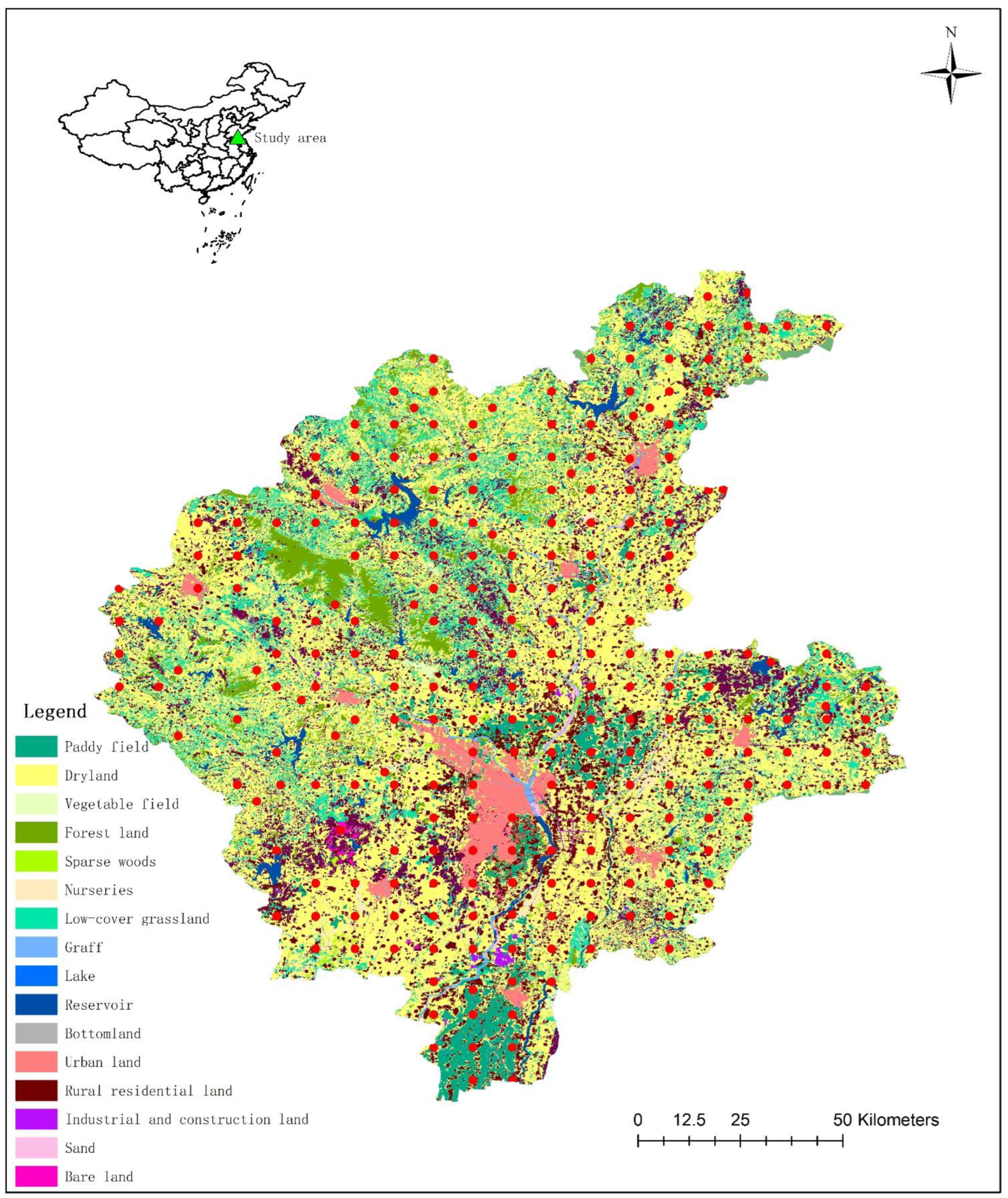
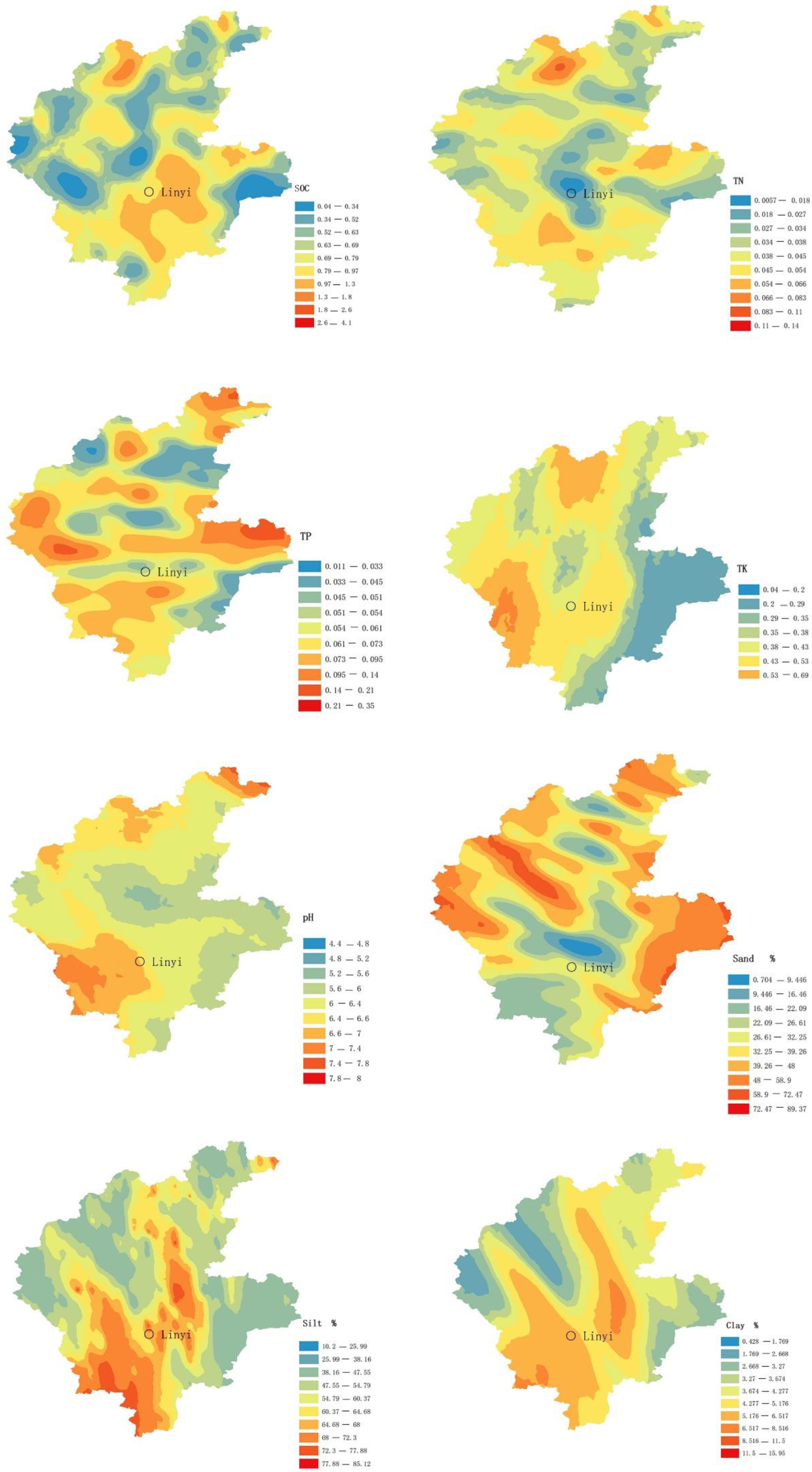
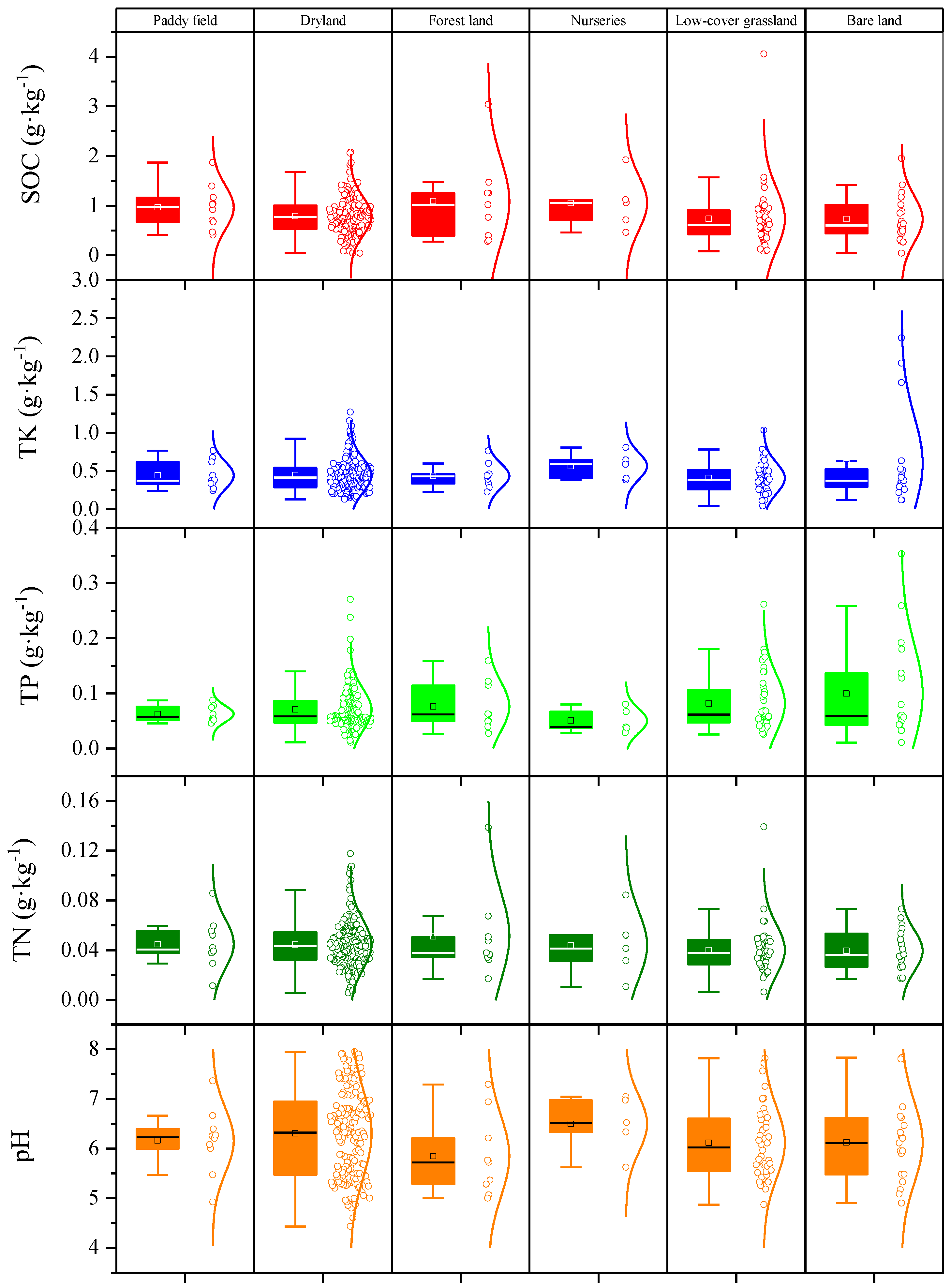
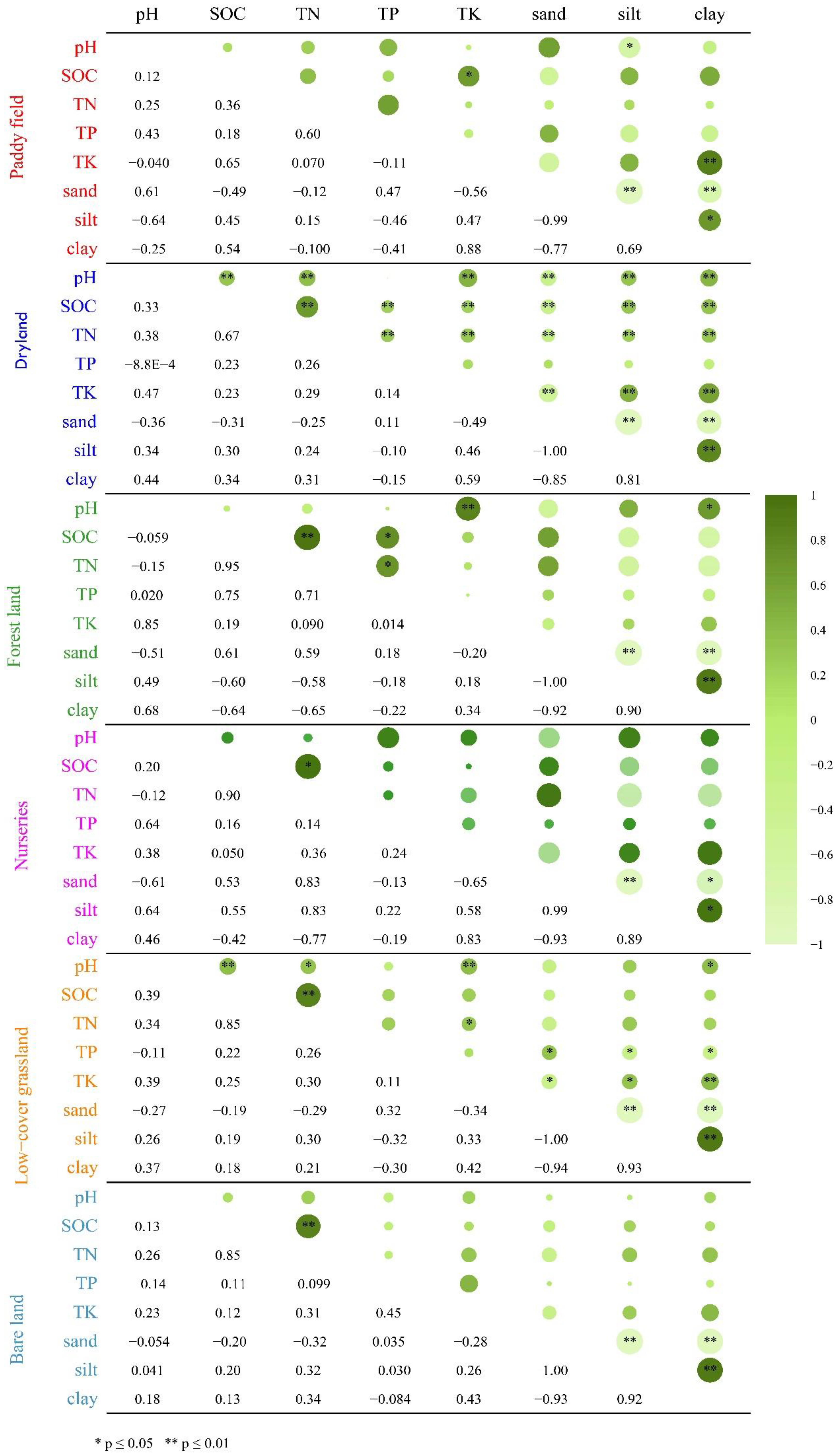
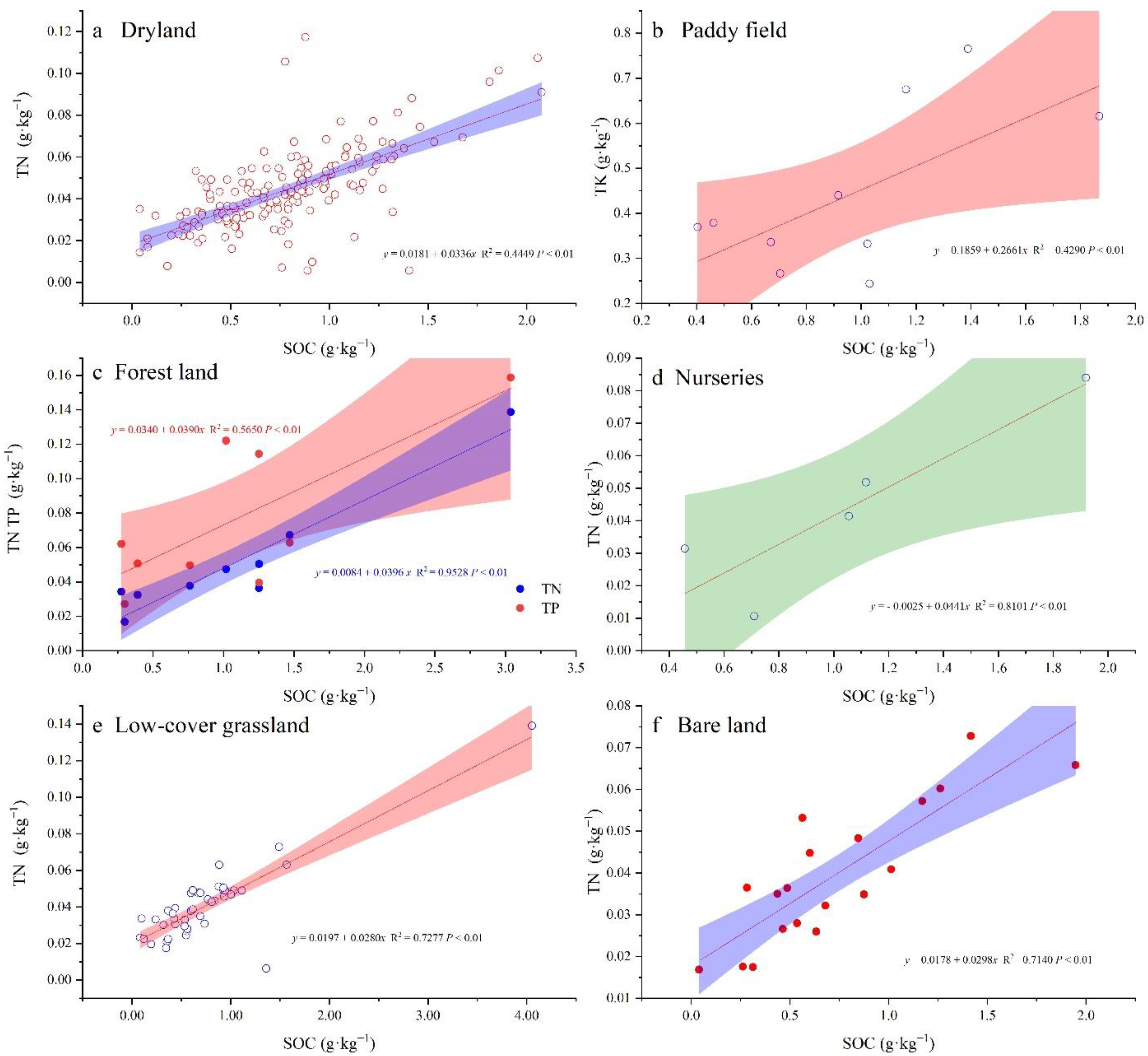
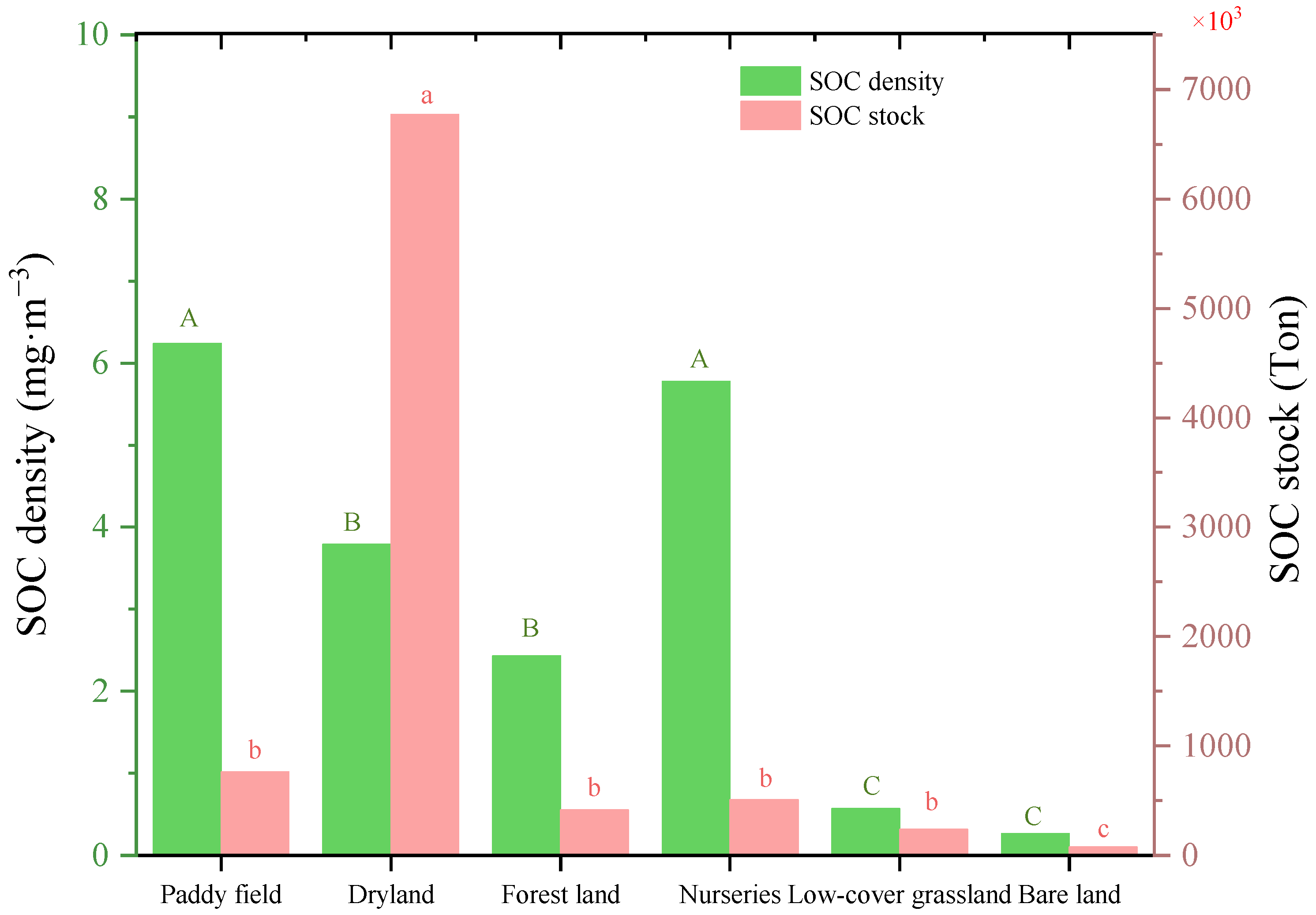

| Land Use | Data Descriptive Statistics | pH | SOC | TN | TP | TK |
|---|---|---|---|---|---|---|
| Paddy field | Mean | 6.16 | 0.96 | 0.04 | 0.06 | 0.44 |
| Standard deviation | 0.59 | 0.40 | 0.02 | 0.01 | 0.16 | |
| Coefficient of variation (%) | 9.55 | 41.63 | 39.74 | 21.22 | 36.84 | |
| Nurseries | Mean | 6.50 | 1.05 | 0.04 | 0.05 | 0.56 |
| Standard deviation | 0.51 | 0.50 | 0.02 | 0.02 | 0.16 | |
| Coefficient of variation (%) | 7.9 | 47.1 | 55.33 | 39.02 | 28.15 | |
| Low-cover grasslands | Mean | 6.12 | 0.73 | 0.04 | 0.08 | 0.41 |
| Standard deviation | 0.71 | 0.61 | 0.02 | 0.05 | 0.20 | |
| Coefficient of variation (%) | 11.6 | 83.01 | 49.68 | 62.92 | 49.06 | |
| Forest land | Mean | 5.85 | 1.08 | 0.05 | 0.08 | 0.44 |
| Standard deviation | 0.77 | 0.81 | 0.03 | 0.04 | 0.15 | |
| Coefficient of variation (%) | 13.16 | 74.52 | 65.47 | 54.96 | 35.32 | |
| Drylands | Mean | 6.30 | 0.79 | 0.04 | 0.07 | 0.44 |
| Standard deviation | 0.88 | 0.38 | 0.02 | 0.04 | 0.22 | |
| Coefficient of variation (%) | 14.01 | 48.81 | 43.4 | 52.9 | 49.9 | |
| Bare land | Mean | 6.12 | 0.73 | 0.04 | 0.10 | 0.60 |
| Standard deviation | 0.79 | 0.45 | 0.02 | 0.09 | 0.60 | |
| Coefficient of variation (%) | 12.98 | 62.39 | 40.67 | 87.26 | 99.86 |
Publisher’s Note: MDPI stays neutral with regard to jurisdictional claims in published maps and institutional affiliations. |
© 2022 by the authors. Licensee MDPI, Basel, Switzerland. This article is an open access article distributed under the terms and conditions of the Creative Commons Attribution (CC BY) license (https://creativecommons.org/licenses/by/4.0/).
Share and Cite
Wu, X.; Wang, L.; An, J.; Wang, Y.; Song, H.; Wu, Y.; Liu, Q. Relationship between Soil Organic Carbon, Soil Nutrients, and Land Use in Linyi City (East China). Sustainability 2022, 14, 13585. https://doi.org/10.3390/su142013585
Wu X, Wang L, An J, Wang Y, Song H, Wu Y, Liu Q. Relationship between Soil Organic Carbon, Soil Nutrients, and Land Use in Linyi City (East China). Sustainability. 2022; 14(20):13585. https://doi.org/10.3390/su142013585
Chicago/Turabian StyleWu, Xiyuan, Lizhi Wang, Juan An, Yun Wang, Hongli Song, Yuanzhi Wu, and Qianjin Liu. 2022. "Relationship between Soil Organic Carbon, Soil Nutrients, and Land Use in Linyi City (East China)" Sustainability 14, no. 20: 13585. https://doi.org/10.3390/su142013585
APA StyleWu, X., Wang, L., An, J., Wang, Y., Song, H., Wu, Y., & Liu, Q. (2022). Relationship between Soil Organic Carbon, Soil Nutrients, and Land Use in Linyi City (East China). Sustainability, 14(20), 13585. https://doi.org/10.3390/su142013585






